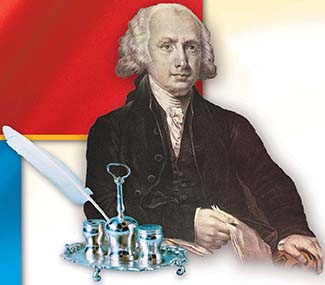SECTION 2: Drafting the Constitution

◄ James Madison
▲ Inkstand and quill pen
WITNESS HISTORY  AUDIO
AUDIO
The Father of the Constitution
James Madison, often referred to as the Father of the Constitution, took detailed notes at the Constitutional Convention. After his death, his notes were published as The Debates in the Federal Convention of 1787. In the Preface, Madison describes the pressure on the delegates:
“At the date of the Convention, the aspect & retrospect of the pol[itical] condition of the U.S. could not but fill the pub[lic] mind with a gloom which was relieved only by a hope that so select a Body would devise an adequate remedy for the existing and prospective evils so impressively demanding it.”
—James Madison, Preface to The Debates in the Federal Convention of 1787
Objectives
- Understand the reasons leaders called for the Constitutional Convention.
- Summarize the rival plans of government proposed at the convention.
- Describe the compromises made in order to reach agreement on the Constitution.
Terms and People
- Alexander Hamilton
- James Madison
- Virginia Plan
- New Jersey Plan
- Great Compromise federalism
- Three-Fifths Compromise
NoteTaking
Reading Skill: Identify Supporting Details In a concept web like the one below, write details about each plan or compromise that led to the creation of the United States Constitution.

Why It Matters After Shays’ Rebellion, many Americans agreed that they needed a stronger federal government to preserve the Union. The Congress called for a convention to meet in Philadelphia in 1787 “for the sole and express purpose of revising the Articles of Confederation.” Instead of revising the Articles of Confederation, however, the delegates created an entirely new constitution that replaced the confederation of the national Union. Section Focus Question: What new system of national government did the delegates agree upon at the Constitutional Convention of 1787?
The Constitutional Convention
By 1787, most Americans agreed that the Articles of Confederation were flawed and needed at least two major changes. First, almost everyone wanted Congress to have the power to regulate interstate and international commerce. Second, most Americans also supported granting Congress the power to tax the people. To draft proposed amendments to the Articles, 12 of the 13 states sent delegates to a special convention in Philadelphia in May 1787. (Rhode Island declined to participate.) Once done, the delegates were supposed to submit the proposed amendments to ratification by the 13 state legislatures.
The convention, then known as the Federal Convention, was slated to begin on May 14. However, only the delegates from Pennsylvania and Virginia made it there on time. More than a week would pass before there were enough delegates to begin the convention.




